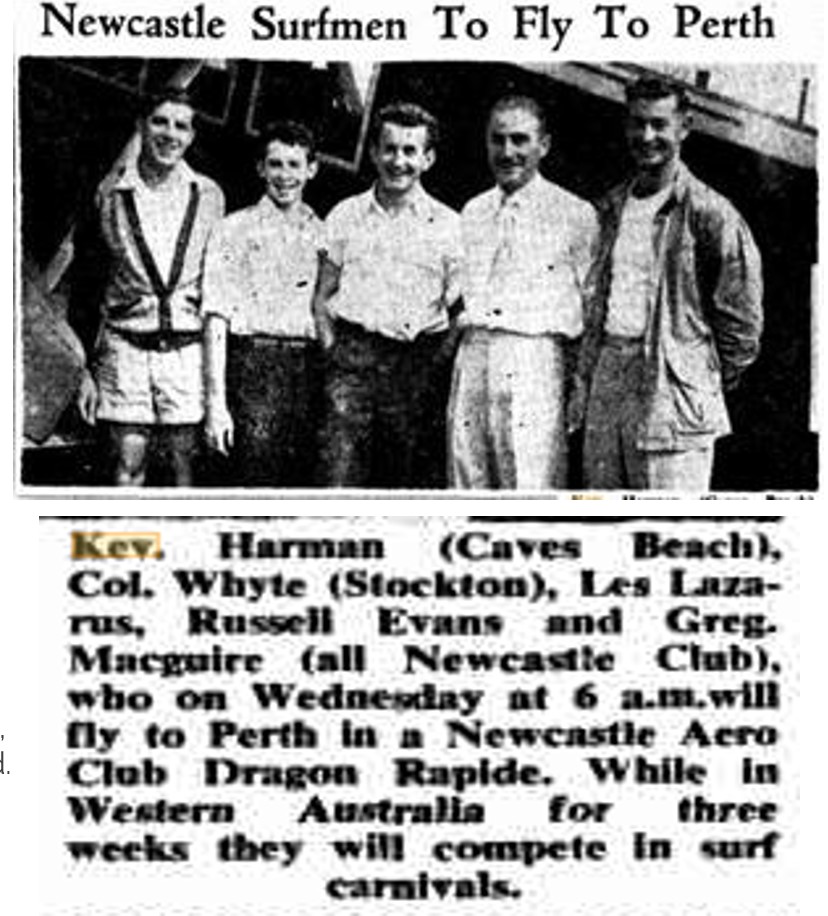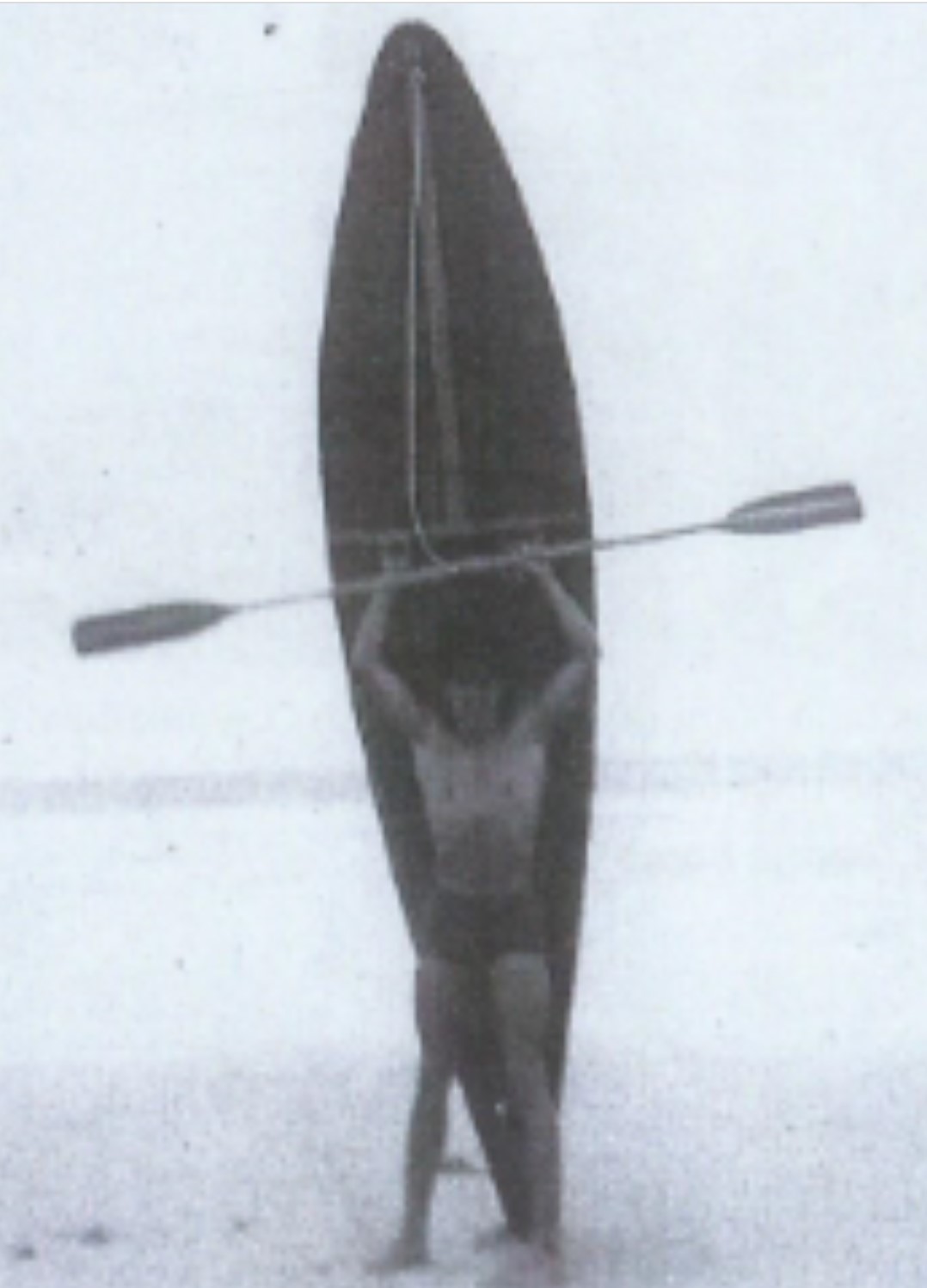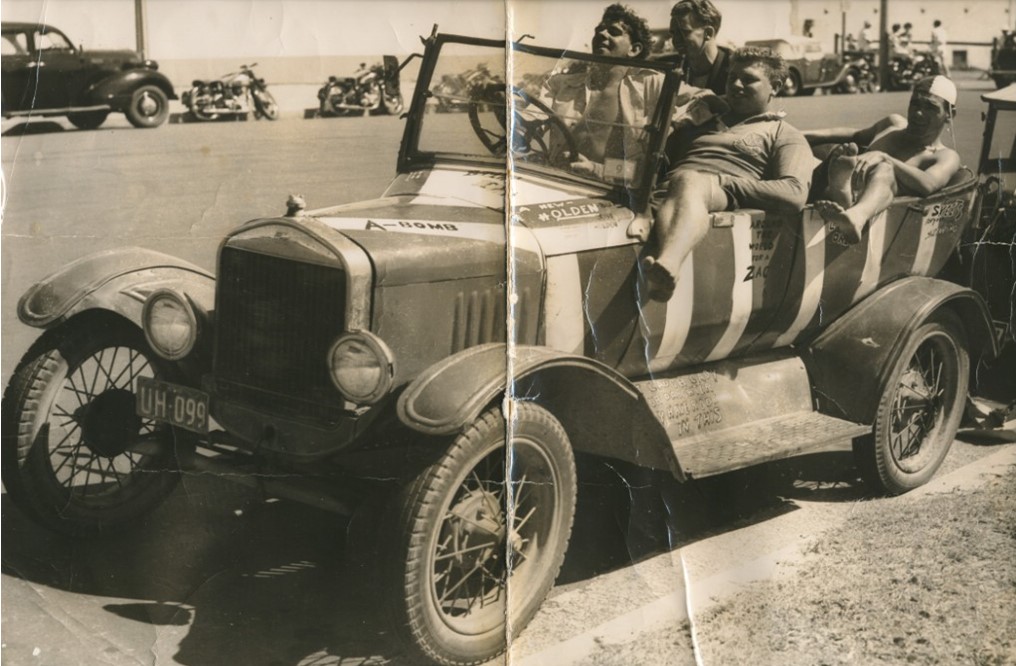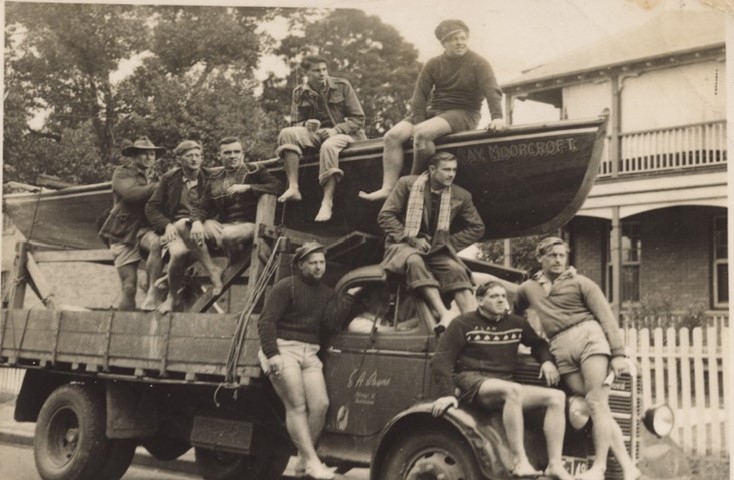Transport
Many outings were had in the 1927 T model ford painted in Caves colours of maroon and white stripes. This impressive vehicle, named “Kayvs Bitch” (photo on left above) made appearances at May Day celebrations and won three blue ribbons – Newcastle Show. With only rear brakes working, it often had to be thrown into reverse gear. They carried an anchor for a joke but had to actually use it when overtaking a tram and the lights turned red. Resorting to use this emergency brake, they threw out the rope and anchor, stopping, but not before the anchor had dug into the bitumen and ripped up a large section of road. On another occasion, they employed the method of putting it into reverse gear. Not only did they stop, but they also then kept reversing, crashing into the car behind. On safari to the Freshwater Carnival, 13 gallons of petrol was guzzled. The running boards were built up with planks to make boxes to carry camping equipment and supplies; with surf ski perched on top. At Brooklyn they decided to set up for the night, a fire going; only to find they were in the middle of a cemetery!
The trips in trucks created a great feeling of mateship as they were used for transport, sleeping, eating, and refreshment.
The Club’s 6th boat, the Gay Moorcroft, on Ern Payne’s truck on the way to 1955 Maitland floods (photo on right above). Caves boat crew were one of the first to arrive in Maitland, where they worked for several days and nights.
In March 2022 the Club again assisted in flood rescue work in Maitland, Singleton and Muswellbrook with their IRB crew of Mal Ingram and Zac Gray. Zac followed in the footsteps of his great-grandfather, Ron Ekert, one of the crew who attended the 1955 Maitland floods.
Australian Surf Titles, Cottesloe, WA, March 1951

March 1951, saw 6 Newcastle lads selected to go to Australian Titles at Cottesloe, Western Australia.
Planning to get a start on the opposition by getting there early to practice and sus out tides and rips, these guys hired a bi-plane from Broadmeadow. The body was made from tubular framing, with canvas wrapped around and laced up underneath like a shoe; with a surface coat of paint over the top. No luxuries like insulation!
The plane was built to take the pilot and four passengers. BUT THEY WERE SIX!. Not to worry, they added two kitchen chairs, not even strapped down. The “chair-men” were nominated to hop out and spin the propellers to start the engines.
With the extra bodies and luggage, the plane barely got off the ground. The original plan – over the mountains to Bathurst to refuel – had to be re-routed to a valley down the coast. Now, very behind schedule, the next stops were Mildura, then Adelaide. In Adelaide the pilot insisted that weight had to be reduced. Luggage was sacrificed, and each member only now had a towel, toiletries, a spare pair of underwear, 1 pair shorts, and a shirt.
Despite the RAAF servicing the plane, there were still mechanical problems. At their stop at Ceduna the Flying Doctor mechanic gave it another tweek. They eventually arrived at Kalgoorlie, eight days after leaving Newcastle. About to take off from Kalgoorlie, one of the engines would not start. Undoing the cowling, bits of the engine fell out and the pilot fainted. Another two days for repairs saw the intrepid travellers arrive in Perth long after the arrival of all of the other competitors. Despite all of their misadventures and finding equipment on arrival, the Newcastle boys took out the top four places. The return journey was relatively uneventful: – only the wheel fell off.
Family and friends back home had been following the journey via the ABC radio who had been monitoring this marathon with nightly news updates on the progress of these daring young men and their flying machine. To listen to a description of the journey by Keven Harman click here.
A sad footnote to this episode: Frank Okulich, the Aust Ch, was taken a few weeks later by a shark off Dixon.
Surf Boats

Surf boats were often named for people who have contributed to or represented the club or for people or organisations who donated the boat. The following are just two examples.
In the mid 1990s the club had a very good junior team, but not enough money to buy a new boat. Gordon Richardson approached Keven Harman with the idea of building a new fibreglass, tuck stern boat for the team, gathering sponsors and doing a major job behind scenes. A few other surfing stalwarts were recruited to assist with construction; even though none had ever undertaken such a task. Countless hours of voluntary labour by “Dad’s Army” delivered the new and shiny “Gordon Richardson” to the club.
In 1998 a request was made for another boat – this time to honour life member, Tom York, a club stalwart, who had been recognised for 50+ years’ service to the club. One of Tom’s most memorable activities had been the organising of the annual carnival, a great community event, which raised much needed club funds. Tom’s health was rapidly failing, so the volunteer boat builders, led by Keven, worked feverishly to complete the boat for their mate. Named the Arthur “Tom” York, it was launched in Tom’s presence.
Poignantly, the day after the launch, Tom’s brave battle was over and he slipped away.
Accident in the Swansea Channel

In February 2004, Keven Harman, who had become an ardent surf skier, was on a practice paddle in Swansea Channel when disaster struck. Despite being Regional, State, Australian and World Masters Champion he was no match for heavy water and another out of control ski.
The runaway ski struck Keven causing severe injuries, including broken ribs and a collapsed lung. Keven was supported in the water by several paddlers holding onto the ski but he could not be lifted on. As the tide was changing, they were all being swept out to sea with the surge of the huge waves. Those who could, came to relieve the tired; some boats tried to assist but the situation on the bar was too dangerous.
Finally, a small tinnie was conscripted to be part of a plan to race in, between waves and tow the ski and Keven into calm waters. In a split second, another wave hit the boat sending it uncontrollably sideways, the propeller connecting with Keven’s feet. Soon after, he lost consciousness due to shock and blood loss.
Finally, the alarm was raised back at Swansea Belmont Surf Life Saving Club –“Harman’s in trouble”. An IRB was despatched. On board the IRB, which maneuvered heavy seas while tending with emergency care; they eventually made it back, carrying the IRB to the waiting ambulance, nearly one and a half hours after the incident began. Many weeks were spent in hospital recovering, particularly battling to save Keven’s right foot.
You can listen to Keven’s description of the accident in our Stories from the Shoebox page.



